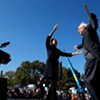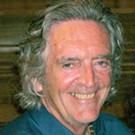Published August 4, 2004 at 4:00 p.m.
Northfield Falls, 5000 miles and 550 years removed from the historic center of the Byzantine Empire, isn't the most likely place in the world to find a painter of Eastern Orthodox iconography.
But this is where Dmitri Andreyev stands atop a scaffold inside the Church of St. Jacob of Alaska, grinding minerals with a mortar and pestle; mixing these pigments with egg yolk, vinegar and water; and then brushing the resultant tempera onto primed walls to create images of the resurrected Christ and the Pentecostal descent of the Holy Spirit.
In what some might see as a stroke of heavenly intervention, Andreyev happened upon the commission to adorn the interior of St. Jacob just a few months after arriving in central Vermont from Manhattan's Lower East Side.
Named for a missionary to then-Russian-controlled Alaska, St. Jacob ranks as Vermont's only affiliate of the Orthodox Church in America. The 35-member congregation of St. Jacob moved about a year ago from temporary quarters in Montpelier to the former Methodist Church it had purchased in Northfield Falls.
Andreyev and his family had, meanwhile, left their crowded apartment in New York and rented a home in South Woodbury, because his American-born wife had long been intrigued by Vermont. Rachel Andreyev, who converted to Eastern Orthodox Christianity prior to marrying Dmitri 12 years ago, also paints in the iconographic style and helps home-school the couple's children. Their three girls and one boy range in age from 10 years to 10 days.
"Vermont feels right to me," says Andreyev, a long-bearded 40-year-old who speaks fluent English with a recognizably Russian accent. The couple is looking for a home to purchase in central Vermont, but he doesn't rule out the possibility of one day returning to Russia. "There's probably enough work for me there these days," he says.
Orthodox Christianity and its associated iconography have been undergoing a revival in Russia since the collapse of the communist system almost 15 years ago. This upwelling within the former Soviet Union coincides with a broader, century-long resurgence of interest in classical icon-painting, or "icon-writing" -- the term its practitioners prefer.
"Many people in Russia are returning to this type of expression because they see it as a true, pure expression," Andreyev explains. He himself composes in the static, schematized style of Russian-Byzantine iconography, which reached its artistic height in the 15th century.
Icon-writers take pride in the aesthetics of their heritage. They believe that flat, stiff-figured iconographic compositions can affect viewers just as powerfully as can Western-style perspective paintings, which trace their origins to Renaissance Italy. "What some may see as unnaturalistic, childish even, may have a profound spiritual meaning," Andreyev declares.
"When I was studying in art school, Renaissance art was very useful to me," he adds. "I appreciate the work of the Italian masters, but I don't see a place for it in an Orthodox church."
That's because traditional iconographers regard their methodology as expressive of a worldview centered on worship of Christ. The Western manner of painting, with its characteristic imitation of nature, likewise reflects an entire -- and opposing -- worldview, whether its inheritors are conscious of it or not, Andreyev argues. "The use of perspective is an expression of a certain philosophy," he says.
According to the church's newsletter, Andreyev spoke to St. Jacob's parishioners earlier this year of an "infection" that entered the Western Christian tradition in the form of Renaissance humanism, which regarded mankind as the focus of life, rather than God.
In addition to its formalist differences from Western art, iconography, by definition, eschews secular subject matter. Its one-dimensional images of Christ, his mother and other scriptural figures are also meant to be instructional. This is an art that treats color and form primarily as teaching tools rather than as elements manipulated to trigger an aesthetic response.
And not only is the work itself devotional, so is the act of creating it. "We believe in what we paint," Andreyev says.
"An icon is a symbol," he adds. "When it loses its clear symbolic qualities, it becomes more like portraiture." In other words, this type of art cannot be created independently of its religious essence or its traditional form.
This transcendent aspect is described in a pamphlet for the New York-based Prosopon School of Iconology, which was founded by Andreyev's father: "Despite the striving for a high artistic level, the focus of the icon-writer is nevertheless on personal spiritual discipline and growth within the guidelines of Orthodox Church teachings."
Vladislav Andrejev has had an enormous, if indirect, influence on Dmitri (who spells his last name differently). Born in St. Petersburg, Russia, in 1938, Andrejev was baptized in the Orthodox faith but did not practice it for very long. His father's artistic temperament led him along a bohemian path, and religious worship was, in any event, firmly discouraged in a society based on Marxist principles. In his twenties, however, Andrejev experienced a spiritual reawakening. He wandered the wilds of southern Russia and sought inspiration from a monk icon-writer at a mountaintop monastery. Andrejev thereafter "felt a need to go deeper into religious art," his son recounts, "but he couldn't support his family by doing that."
Andrejev emigrated to the United States in 1980. He became a teacher as well as a practitioner of Russian-Byzantine iconography, working in New York for seven years at the School of Sacred Arts. That institution attracts devotees of many different faiths -- including Tibetan Buddhists, for example -- who share an aspiration to learn traditional methods of religiously inspired painting.
Back in St. Petersburg, where he lived with his mother -- also an art teacher -- Dmitri Andreyev came across a New York Times article describing his father's work at the School of Sacred Arts. "At that time [the mid-'80s], I was kind of desperate about what kind of art I should be doing," recalls Andreyev, who had been studying painting within the context of a society in which religious believers were still ostracized.
Even though he was not a member of the Orthodox Church, Andreyev recalls being interested in iconography "because it was something that was satisfying an inner calling I had. I just didn't know what to do about it."
The Times story about his father's achievements in New York proved decisive in shaping Andreyev's own life. He emigrated to the United States in 1989, was baptized into the faith of his father soon after, and later became a teacher of iconography.
Circumstances have now led him to Northfield Falls, where his two murals are about half-completed. Andreyev is aiming to finish this initial phase of the St. Jacob iconography project in September prior to traveling with his family to Minnesota, where he and his father will spend two months writing icons in the cupola of a Byzantine-style church.
The painting on the left front wall of St. Jacob's depicts Christ's descent into Hell following his crucifixion and prior to his resurrection. In this apocryphal scene not recounted in scripture, Christ clasps the hands of Adam and Eve while the Old Testament Kings David and Solomon look on. Three concentric circles surround the central figure. The inner, black circle is meant to represent "the incomprehensible essence of Christ," Andreyev explains, while the yellow and red outer circles signify "the light, the glory of Christ."
On the right front wall, the artist has depicted the apostles gathered to receive the blessing of the Holy Spirit in the form of tongues of fire -- which Andreyev has not yet painted.
The grand scheme for the church calls for Andreyev to create two more murals: one above the altar showing Christ enthroned on Judgment Day, and a Madonna and Child composition on a protruding wall of the apse.
In the scenes becoming visible on the church's walls and in Andreyev's sketches for the rest of the project, all the figures -- save Satan -- wear serene expressions befitting those who have found peace and salvation. "An icon," Andreyev notes, "is supposed to proclaim reality not as it is, but as it should be." m
Services are held at St. Jacob of Alaska Church on Saturday at
5 p.m. and Sunday at 9:10 a.m. Call 485-9121 or log on to
stjacobofalaska.org for more information.
More By This Author
Speaking of Art, eyewitness
-

Q&A: Catching Up With the Champlain Valley Quilt Guild
Apr 10, 2024 -

Video: The Champlain Valley Quilt Guild Prepares for Its Biennial Quilt Show
Apr 4, 2024 -

Q&A: Meet a Family in Waterbury That Embraces Halloween Year-Round
Feb 14, 2024 -

Video: Goth Family in Waterbury: Sarah, Jay and Zarek Vogelsang-Card
Feb 8, 2024 -

Q&A: Art Entrepreneurs Tessa and Torrey Valyou Celebrate 15 Years of New Duds
Oct 11, 2023 - More »
Comments
Comments are closed.
From 2014-2020, Seven Days allowed readers to comment on all stories posted on our website. While we've appreciated the suggestions and insights, right now Seven Days is prioritizing our core mission — producing high-quality, responsible local journalism — over moderating online debates between readers.
To criticize, correct or praise our reporting, please send us a letter to the editor or send us a tip. We’ll check it out and report the results.
Online comments may return when we have better tech tools for managing them. Thanks for reading.














































